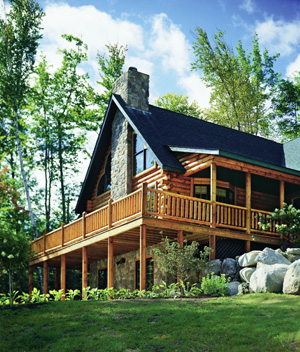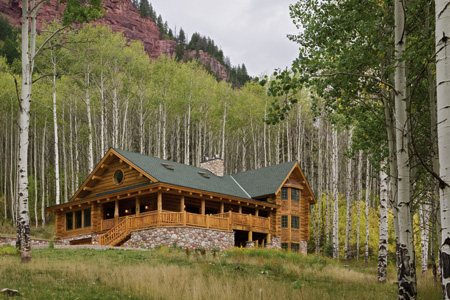You have dreamed about living in a log home for years. You have collected photos and stashed away log company floorplans and magazine clips. You’ve probably done a lot of the fun stuff, but have you thought about how you’re going to pay for this dream?
If you are like most Americans, you will have to take out a mortgage to pay for your dream home. And, with a brand-new log home, you will also have to take out a loan to get it built. To be better prepared before you break out your checkbook, you should gain an understanding of how the log home mortgage process works.
Be encouraged that you will be financially prepared to build your dream home by knowing the steps to take. “There are a lot of folks who are tuned into the media and don’t have all of the information,” says Greg Ebersole of American Log Mortgage in Mountville, Pennsylvania. “Money is available, but the criteria have changed a bit. A well-qualified customer two years ago would be approved just as easily today.”
Preapproval
In the preapproval process, you will be given a written commitment from the lender to loan you the money. Your preapproval confirms a lot of the basics: your credit rating, the kind of interest rate you might expect to pay, and finally, how much you can afford to spend. This helps you to set your log house-hunting budget. “A preapproval gives people a good comfort level about what they can truly afford,” says Greg Ebersole. “Many people are surprised when they can afford more than they think.” Be prepared to hand over a multitude of documents to the lender. The lender will check your employment status, verify salary, debts, and assets, and run a credit report. At this time, you will also need to supply items like pay stubs, tax returns or W-2s, proof of other income and assets, bank records, and debt. Having your credit checked now will give you time to clear up any discrepancies before applying for the loan. This process should only take a few days if documents are sent electronically.
Lenders
When it comes to finding a lender for your log home, you do have a variety of choices. You can go to the same lenders that you would go to if you were buying a conventional home—a local bank or credit union, a mortgage broker, or an online mortgage website. Also, ask your log home company representatives if they can recommend a lender that they’ve worked with. Be aware that not all lenders are knowledgeable about log construction and may not be willing to fund it. The good news is that there are lenders out there who specialize in log home lending. “We have a familiarity with log homes,” says Greg Ebersole. “Other lenders may be apprehensive about lending for them. They have a preconceived idea that there will be challenges. We know the log home process and understand the different log home needs such as log deliveries and when money needs to get paid.”
Application
If you’ve already been preapproved for a loan, you’ve dealt with most of the necessary loan paperwork and given your lender a list of relevant financial information. If you haven’t gone through this process, you will have to gather the documents mentioned above, as well as other specific documents that your lender may ask for. Once completed, your application is sent to an underwriter who reviews and verifies your information. The underwriter also determines any loan conditions required before the loan can be approved, such as supplying current paycheck stubs.

Golden Eagle Log Homes
The final part of the application process is the appraisal. An appraisal is used to determine the value of your log home. This ensures that you’re not borrowing more than it’s worth once your log home is built. In a typical appraisal, an appraiser compares other homes of similar size and square footage, known as comparables or comps, in the area in which you will build. Most banks may require one to three log home comps for appraisals, although this may be difficult. “People who build log homes keep their homes for many years,” Greg Ebersole says. “So there is not an abundance of resales. Log homes are still homes. So we will use comps in the area that are not log.” Log home lending specialists will also base the appraisal on your building plans, specifications, building contract, log package contract, and building lot.
Common Mortgages
There are a variety of mortgage types to choose from. Research the options and talk to your lender about the one that will best fit your needs. You will assume the mortgage once your home has been built.
A fixed-rate mortgage is just that: a mortgage that has an interest rate that doesn’t vary during the duration of the loan. This makes budgeting and planning over the years easier with no surprises to your monthly payment.
With an adjustable-rate mortgage (ARM), the interest rate is fixed for a set amount of time, then adjusts. So, in time, your monthly payments will fluctuate. This could be beneficial if rates go down, but demanding if they rise.
Construction Loans
Construction loans are short-term loans, usually six to 12 months, that cover the costs associated with building your log home. Construction loans typically require interest-only payments during construction and become due upon completion. Funds are disbursed as “draws” during the building process to you and your contractor following a construction draw schedule. Once the construction is complete and a certificate of occupancy is issued, a permanent mortgage is needed.
Some lenders offer construction-to-permanent mortgages. This single loan converts into a permanent mortgage at the end of construction. A modification-closing document is signed to convert the construction loan to permanent. Many lenders can also cover the cost of buying land within this loan. The other option is to obtain separate loans for both construction and permanent.
Keep in mind that the lender will also have to approve your builder. Your builder should be prepared to supply relevant information including references, a copy of the construction contract, and the construction draw schedule.
Closing
When you go to closing depends on which type of mortgage you choose. With a construction-to-permanent loan, or “one-time close” loan, you will go to closing one time before construction begins. The benefit is that you are only paying closing costs once and the loan is automatically converted from construction to permanent when your log home is ready.
If you choose to do a construction loan and mortgage separately, or a “two-time” loan, you will go to closing twice, before construction and after the home is complete, incurring two sets of closing costs.
Now you know the steps to take. So, add some lender brochures and materials to your pile of log home plan books to ensure that your log home is not only beautiful, but affordable, too.

